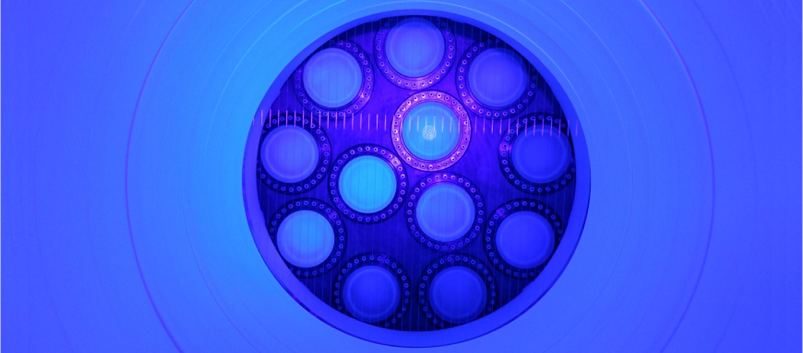Experimental Particle Physics

This research line is devoted to experimental neutrino physics. It focuses on the study of the neutrinoless double beta decay (NEXT project), a process whose detection would make it possible to answer the fundamental question of whether the neutrino is its own antiparticle, i.e., a Majorana fermion, with far reaching implications in particle physics and cosmology.
The researchers involved in this line are also leading the detection of coherent elastic neutrino-nucleus scattering at the upcoming European Spallation Source, with the GanESS and ESSCEvNS projects. These experiments will allow to take advantage of the most powerful neutron source in the world to probe the Standard Model of particle physics with unprecedented sensitivity.
In addition, they are part of the Hyper-Kamiokande collaboration, which will deploy the largest neutrino detector in the world with the goal of investigating the origin of matter and the inner workings of the Sun and supernovas.
The design and development of the experimental technology required to answer these questions has natural connections with other fields of physics (condensed matter, surface physics, atomic physics, etc.) and may result in potential technological applications in areas such as sensorics or medical physics (the PETALO project).
Specific topics
- NEXT: a project to detect a neutrinoless double beta decay reaction.
- PETALO: a project to develop a high-resolution new generation Positron Emission Tomography (PET) scanner.
- GanESS: a project to detect coherent elastic neutrino-nucleus scattering with a xenon time projection chamber.
- ESSCEvNS: a project to detect coherent elastic neutrino-nucleus scattering with cryogenic cesium iodide crystals and p-type point contact germanium detectors.
Related publications
-
 1
Search for a nonrelativistic boson in two-body antimuon decay
1
Search for a nonrelativistic boson in two-body antimuon decay
J. I. Collar, P. S. Cooper, and C. M. Lewis
Phys. Rev. Lett. 131, 24 (2023). -
 2
Demonstration of neutrinoless double beta decay searches in gaseous xenon with NEXT
2
Demonstration of neutrinoless double beta decay searches in gaseous xenon with NEXT
P. Novella, M. Sorel, A. Uson, C. Adams, H. Almazan, V. Alvarez, B. Aparicio, I. Aranburu, L. Arazi, I. J. Arnquist, F. Auria-Luna, S. Ayet, C. D. R. Azevedo, K. Bailey, F. Ballester, M. del Barrio-Torregrosa, A. Bayo, J. M. Benlloch-Rodriguez, F. I. G. M. Borges, S. Bounasser, et al.
J. High Energy Phys. 2023, (2023). -
 3
Ba+2 ion trapping using organic submonolayer for ultra-low background neutrinoless double beta detector
3
Ba+2 ion trapping using organic submonolayer for ultra-low background neutrinoless double beta detector
P. Herrero-Gómez, J. P. Calupitan, M. Ilyn, A. Berdonces-Layunta, T. Wang, D. G. de Oteyza, M. Corso, R. González-Moreno, I. Rivilla, B. Aparicio, A. I. Aranburu, Z. Freixa, F. Monrabal, F. P. Cossío, J. J. Gómez-Cadenas, C. Rogero and NEXT collaboration
Nat. Commun. 13, 7741 (2022). -
 4
Neutral bremsstrahlung emission in xenon unveiled
4
Neutral bremsstrahlung emission in xenon unveiled
C. A. O. Henriques, P. Amedo, J. M. R. Teixeira, D. Gonzalez-Diaz, C. D. R. Azevedo, A. Para, J. Martin-Albo, A. S. Hernandez, J. J. Gomez-Cadenas, D. R. Nygren, C. M. B. Monteiro, C. Adams, V. Alvarez, L. Arazi, I. J. Arnquist, K. Bailey, F. Ballester, J. M. Benlloch-Rodriguez, F. I. G. M. Borges, N. Byrnes, et al.
Phys. Rev. X 12, 2 (2022). -
 5
Supernova model discrimination with Hyper-Kamiokande
5
Supernova model discrimination with Hyper-Kamiokande
K. Abe, P. Adrich, H. Aihara, R. Akutsu, I. Alekseev, A. Ali, F. Ameli, I. Anghel, V. Anthony, M. Antonova, A. Araya, Y. Asaoka, Y. Ashida, V. Aushev, F. Ballester, I. Bandac, M. Barbi, G. J. Barker, G. Barr, M. Batkiewicz-Kwasniak, et al.
Astrophys. J. 916, 1 (2021). -
 6
Sensitivity of a tonne-scale NEXT detector for neutrinoless double-betadecay searches
6
Sensitivity of a tonne-scale NEXT detector for neutrinoless double-betadecay searches
C. Adams, V. Alvarez, L. Arazi, I. J. Arnquist, C. D. R. Azevedo, K. Bailey, F. Ballester, J. M. Benlloch-Rodriguez, F. I. G. M. Borges, N. Byrnes, S. Carcel, V. Carrion, S. Cebrian, E. Church, C. A. N. Conde, T. Contreras, A. A. Denisenko, G. Diaz, J. Diaz, J. Escada, et al.
J. High Energy Phys. 2021, 164 (2021). -
 7
Fluorescent bicolour sensor for low-background neutrinoless double β decay experiments
7
Fluorescent bicolour sensor for low-background neutrinoless double β decay experiments
I. Rivilla, B. Aparicio, J. M. Bueno, D. Casanova, C. Tonnele, Z. Freixa, P. Herrero, C. Rogero, I. Miranda, R. M. Martinez-Ojeda, F. Monrabal, B. Olave, T. Schafer, P. Artal, D. Nygren, F. P. Cossio, and J. J. Gomez-Cadenas
Nature 583, 48+ (2020). -
 8
Coherent elastic neutrino-nucleus scattering at the European SpallationSource
8
Coherent elastic neutrino-nucleus scattering at the European SpallationSource
D. Baxter, J. I. Collar, P. Coloma, C. E. Dahl, I. Esteban, P. Ferrario, J. J. Gomez-Cadenas, M. C. Gonzalez-Garcia, A. R. L. Kavner, C. M. Lewis, F. Monrabal, J. M. Vidal, P. Privitera, K. Ramanathan, and J. Renner
J. High Energy Phys. 2020, (2020). -
 9
Electroluminescence TPCs at the thermal diffusion limit
9
Electroluminescence TPCs at the thermal diffusion limit
C. A. O. Henriques, C. M. B. Monteiro, D. Gonzalez-Diaz, C. D. R. Azevedo, E. D. C. Freitas, R. D. P. Mano, M. R. Jorge, A. F. M. Fernandes, J. J. Gomez-Cadenas, L. M. P. Fernandes, C. Adams, V. Alvarez, L. Arazi, K. Bailey, F. Ballester, J. M. Benlloch-Rodriguez, F. I. G. M. Borges, A. Botas, S. Carcel, J. V. Carrion, et al.
J. High Energy Phys. 2019, 1 (2019).
